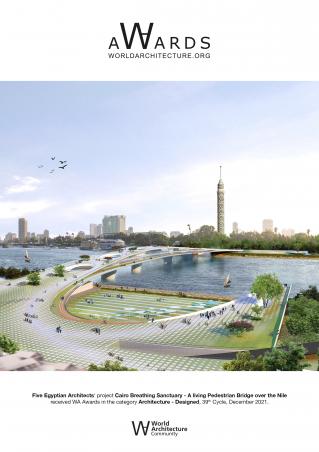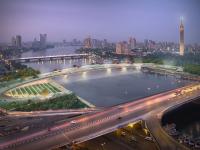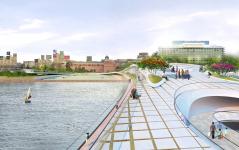The objective is to maximize pedestrian exposure to the Nile via stitching the urban fabric of the two banks. The bridge acts as an urban park with two concealed lower floor levels above the Nile, including recreational, commercial, cultural, administrative, and social spaces. The structure maximizes the visual connectivity between the indoor and outdoor spaces and the natural ventilation and lighting. The project is a breathing sanctuary for people that hugs pedestrian-friendly spaces.
The proposed design site is located in the center of Cairo, over the Nile River, connecting its banks. Due to the present development of Egypt's administrative capital to the east of Cairo, there is an inevitable scope for regeneration in the selected project site. The idea was to design a living pedestrian bridge over the Nile, connecting Al-Tahrir to Al-Zamalek, and to re-imagine the public space on the east bank of the Nile. The design stitches the urban fabric of the two banks together, which resulted in a massive form, firstly connecting an unobstructed linear path (between the Egyptian Museum and Cairo Tower) and secondly, a semi-elliptical path housing the Cultural Nile Plaza and the Elevated Garden acting as a socio-economic hub. The project includes creating a tunnel system for vehicular traffic and relocation of the exit of the 6th October Bridge while the concept facilitates space for an urban park blended into the land on both sides with two concealed floor levels above the Nile. The idea re-imagines and reflects the historical landscapes of Egypt for a future heading towards promoting green cities and sustainable environments.
2020
Tamayouz Excellence Award has announced the winners of its Rifat Chadirji Prize 2020, an annual thematic prize named after the prolific Iraqi architect and academic Dr. Rifat Chadirji, is a thematic international prize that seeks designs responding to local challenges. The prize, which is part of Tamayouz’s program of championing and celebrating architecture in the Near East and North Africa, aims to introduce local challenges to the world and invite architects, designers, and planners to submit their concepts. It also aims to establish an uncompromising open source of ideas that tackle social issues through design. It is worth mentioning that dame Zaha Hadid was a jury member in Tamayouz Excellence Award 2012.
The first-place winner for the Rifat Chadirji Prize 2020 and the People’s Choice Award is a team of five from Cairo, Egypt: Ali Khaled Elewa, Mostafa Ahmed Zakaria, Sherif Khaled Abdelkhaleq, Hoda Essam Abdelmawla, and Ebtisam Elgizawy. The winning team was selected out of 177 submissions from 42 countries received this year.
Description, as mentioned by the architects:
The main objective of the living bridge is to maximize pedestrian exposure to the Nile, via stitching the urban fabric of the two banks together.
The form was generated as a result of two main paths. Firstly, an unobstructed linear path directly linking the Egyptian Museum with Cairo Tower. Secondly, a semi-elliptical path was generated to embrace the two opposite banks; the Cultural Nile Plaza and the Elevated Garden. This path is meant to be pleasant, playful, and links successive attractions and socio-economic hubs.
The paths incorporate together to create a single continuous leaning body blended into the land on both sides, offering panoramic views of the Cairo downtown, Nile, and the surrounding iconic attractions.
Moreover, the bridge is acting as an urban park with two concealed lower floor levels above the Nile, including recreational, commercial, cultural, administrative, and social spaces.
The six flowing structural columns maximize the visual connectivity between the indoor and outdoor spaces and the natural ventilation and lighting. Besides, the top layer consists of concrete tiles and grass, driven parametrically based on pedestrian flow.
For the sake of achieving the project objective, it is proposed to bury a 200 m stretch of road along the Nile River and build a park on top. Additionally, it is proposed to relocate the exit of the sixth of October Bridge.
Accordingly, Cairo's central downtown will be valued as a breathing sanctuary for people and will transform into pedestrian-friendly spaces.
Architects: Ali Khaled Elewa, Mostafa Ahmed Zakaria, Sherif Khaled Abdelkhaleq, Hoda Essam Abdelmawla, and Ebtisam Elgizawy
Cairo Breathing Sanctuary - A living Pedestrian Bridge over the Nile by Five Egyptian Architects in Egypt won the WA Award Cycle 39. Please find below the WA Award poster for this project.

Downloaded 0 times.











